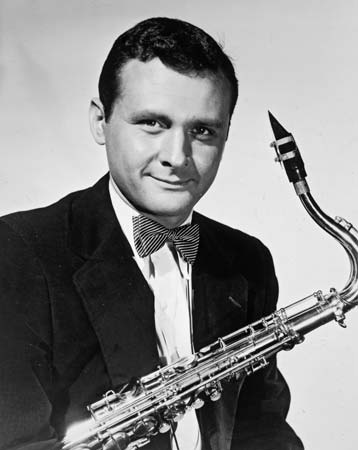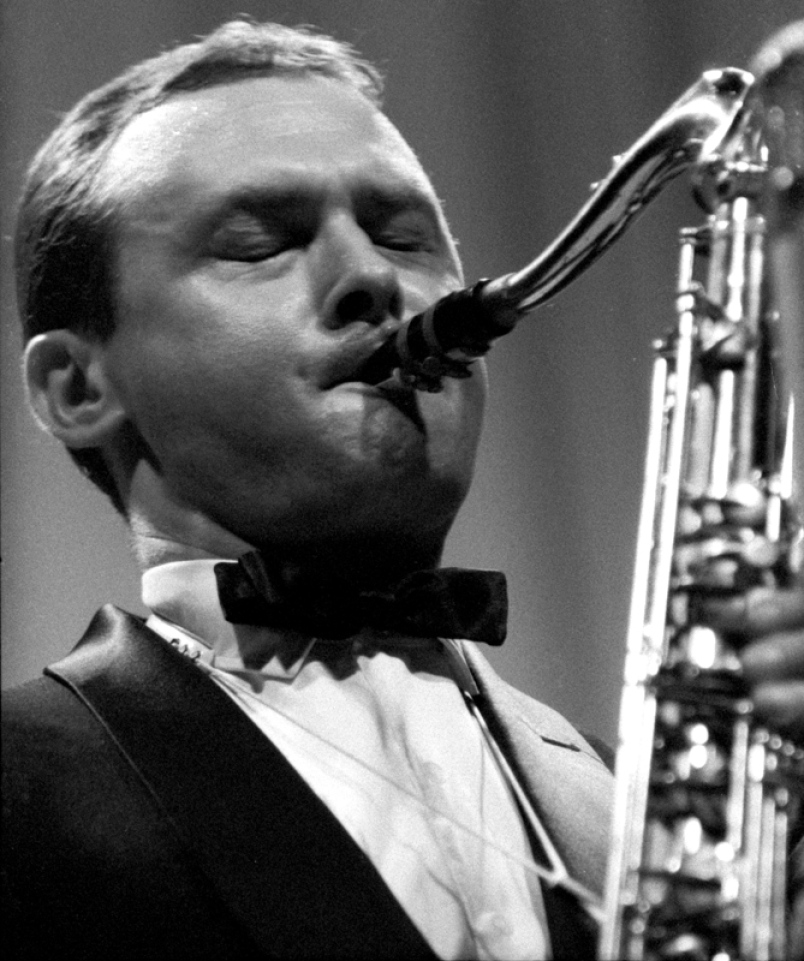Stan Getz (Stanley Getz)

Stan Getz’s reputation was greatly enhanced by his featured status on Johnny Smith’s 1952 album Moonlight in Vermont, that year’s top jazz album. The single of the title tune became a hit that stayed on the charts for months. In the mid to late 1950s working from Scandinavia, Getz became popular playing cool jazz with Horace Silver, Johnny Smith, Oscar Peterson, and many others. His first two quintets were notable for their personnel, including Charlie Parker’s rhythm section of drummer Roy Haynes, pianist Al Haig and bassist Tommy Potter. A 1953 line-up of the Dizzy Gillespie/Stan Getz Sextet featured Gillespie, Getz, Peterson, Herb Ellis, Ray Brown and Max Roach. Returning to the U.S. from Europe in 1961, Getz became a central figure in introducing bossa nova music to the American audience. Teaming with guitarist Charlie Byrd, who had just returned from a U.S. State Department tour of Brazil, Getz recorded Jazz Samba in 1962 and it quickly became a hit. Getz won the Grammy for Best Jazz Performance of 1963 for “Desafinado”, from the same album. It sold over one million copies, and was awarded a gold disc. His second bossa nova album, also recorded in 1962, was Big Band Bossa Nova with composer and arranger Gary McFarland. As a follow-up, Getz recorded the album, Jazz Samba Encore!, with one of the originators of bossa nova, Brazilian guitarist Luiz Bonfá. It also sold more than a million copies by 1964, giving Getz his second gold disc.
He then recorded the album Getz/Gilberto, in 1963, with Antonio Carlos Jobim, João Gilberto and his wife, Astrud Gilberto. Their “The Girl from Ipanema” won a Grammy Award. The piece became one of the most well-known Latin jazz tracks. Getz/Gilberto won two Grammys (Best Album and Best Single). A live album, Getz/Gilberto Vol. 2, followed, as did Getz Au Go Go (1964), a live recording at the Cafe Au Go Go. Getz’s love affair with Astrud Gilberto brought an end to his musical partnership with her and her husband, and he began to move away from bossa nova and back to cool jazz. While still working with the Gilbertos, he recorded the jazz album Nobody Else but Me (1964), with a new quartet including vibraphonist Gary Burton, but Verve Records, wishing to continue building the Getz brand with bossa nova, refused to release it. It came out 30 years later, after Getz had died. In 1972, Getz recorded in the fusion idiom with Chick Corea, Tony Williams and Stanley Clarke, and in this period experimented with an Echoplex on his saxophone. He had a cameo in the film The Exterminator (1980).
In the mid-1980s Stan Getz worked regularly in the San Francisco Bay area and taught at Stanford University as an artist-in-residence at the Stanford Jazz Workshop until 1988. In 1986, he was inducted into the Down Beat Jazz Hall of Fame. During 1988, Getz worked with Huey Lewis and the News on their Small World album. He played the extended solo on part 2 of the title track, which became a minor hit single. His tenor saxophone of choice was the Selmer Mark VI. Stan Getz died of liver cancer on June 6, 1991. Stan’s ashes were poured out of his saxophone case six miles off the coast of Marina del Rey, California by his grandson, Chris.
Born
- February, 02, 1927
- USA
- Philadelphia, Pennsylvania
Died
- June, 06, 1991
- USA
- Malibu, California
Cause of Death
- liver cancer
Other
- Cremated



